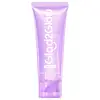What's inside
What's inside
 Key Ingredients
Key Ingredients

 Benefits
Benefits

 Concerns
Concerns

 Ingredients Side-by-side
Ingredients Side-by-side

Water
Skin ConditioningPotassium Cocoyl Glycinate
Acrylates/Steareth-20 Methacrylate Crosspolymer
Sodium Lauroamphoacetate
CleansingVaccinium Angustifolium Fruit Extract
Skin ProtectingPotassium Cocoate
EmulsifyingCeramide EOP
Skin ConditioningCeramide Ng
Skin ConditioningCeramide NP
Skin ConditioningCeramide As
Skin ConditioningCeramide AP
Skin ConditioningSodium Chloride
MaskingGlycosyl Trehalose
Emulsion StabilisingPotassium Hydroxide
BufferingCitric Acid
BufferingHydrogenated Starch Hydrolysate
HumectantLauryl Hydroxysultaine
CleansingCaprylyl Glycol
EmollientDisodium EDTA
Aroma
Phenoxyethanol
PreservativeWater, Potassium Cocoyl Glycinate, Acrylates/Steareth-20 Methacrylate Crosspolymer, Sodium Lauroamphoacetate, Vaccinium Angustifolium Fruit Extract, Potassium Cocoate, Ceramide EOP, Ceramide Ng, Ceramide NP, Ceramide As, Ceramide AP, Sodium Chloride, Glycosyl Trehalose, Potassium Hydroxide, Citric Acid, Hydrogenated Starch Hydrolysate, Lauryl Hydroxysultaine, Caprylyl Glycol, Disodium EDTA, Aroma, Phenoxyethanol
Centella Asiatica Extract 41%
CleansingWater
Skin ConditioningLauryl Hydroxysultaine
CleansingGlycerin
HumectantDisodium Cocoamphodiacetate
CleansingPotassium Cocoyl Glycinate
Sodium Chloride
MaskingPotassium Cocoate
EmulsifyingSodium Lauroyl Glutamate
Vitis Vinifera Fruit Extract
Skin ConditioningPyrus Malus Fruit Extract
Skin ConditioningCarica Papaya Fruit Extract
Skin ConditioningPrunus Mume Fruit Extract
HumectantMadecassoside
Antioxidant1,2-Hexanediol
Skin ConditioningXylitylglucoside
HumectantAnhydroxylitol
HumectantXylitol
HumectantNiacinamide
SmoothingAcrylates/C10-30 Alkyl Acrylate Crosspolymer
Emulsion Stabilising3-O-Ethyl Ascorbic Acid
Skin ConditioningTrehalose
HumectantButylene Glycol
HumectantPanthenol
Skin ConditioningAgave Tequilana Leaf Extract
AstringentGlucose
HumectantCaprylic/Capric Triglyceride
MaskingHexylene Glycol
EmulsifyingPentylene Glycol
Skin ConditioningCitric Acid
BufferingPotassium Benzoate
PreservativeEthylhexylglycerin
Skin ConditioningDisodium EDTA
Centella Asiatica Extract 41%, Water, Lauryl Hydroxysultaine, Glycerin, Disodium Cocoamphodiacetate, Potassium Cocoyl Glycinate, Sodium Chloride, Potassium Cocoate, Sodium Lauroyl Glutamate, Vitis Vinifera Fruit Extract, Pyrus Malus Fruit Extract, Carica Papaya Fruit Extract, Prunus Mume Fruit Extract, Madecassoside, 1,2-Hexanediol, Xylitylglucoside, Anhydroxylitol, Xylitol, Niacinamide, Acrylates/C10-30 Alkyl Acrylate Crosspolymer, 3-O-Ethyl Ascorbic Acid, Trehalose, Butylene Glycol, Panthenol, Agave Tequilana Leaf Extract, Glucose, Caprylic/Capric Triglyceride, Hexylene Glycol, Pentylene Glycol, Citric Acid, Potassium Benzoate, Ethylhexylglycerin, Disodium EDTA
 Reviews
Reviews

Ingredients Explained
These ingredients are found in both products.
Ingredients higher up in an ingredient list are typically present in a larger amount.
Citric Acid is an alpha hydroxy acid (AHA) naturally found in citrus fruits like oranges, lemons, and limes.
Like other AHAs, citric acid can exfoliate skin by breaking down the bonds that hold dead skin cells together. This helps reveal smoother and brighter skin underneath.
However, this exfoliating effect only happens at high concentrations (20%) which can be hard to find in cosmetic products.
Due to this, citric acid is usually included in small amounts as a pH adjuster. This helps keep products slightly more acidic and compatible with skin's natural pH.
In skincare formulas, citric acid can:
While it can provide some skin benefits, research shows lactic acid and glycolic acid are generally more effective and less irritating exfoliants.
Most citric acid used in skincare today is made by fermenting sugars (usually from molasses). This synthetic version is identical to the natural citrus form but easier to stabilize and use in formulations.
Read more about some other popular AHA's here:
Learn more about Citric AcidDisodium EDTA plays a role in making products more stable by aiding other preservatives.
It is a chelating agent, meaning it neutralizes metal ions that may be found in a product.
Disodium EDTA is a salt of edetic acid and is found to be safe in cosmetic ingredients.
Learn more about Disodium EDTAWe don't have a description for Lauryl Hydroxysultaine yet.
This ingredient is the potassium salt of coconut acid. Coconut acid is created by mixing fatty acids from coconut oil.
It is an emulsifier, surfactant, and cleanser. According to a manufacturer, it contains glycerin.
Potassium Cocoyl Glycinate is an amino acid-based surfactant and cleaning agent. This ingredient can be derived from animals or plants. It may also be synthetically created from fatty acids of the coconut and glycine.
Potassium Cocoyl Glycinate is a gentle surfactant. Surfactants help gather the dirt, oil, and other pollutants from your skin to be rinsed away. It is a mild cleanser and naturally produces foam.
Chances are, you eat sodium chloride every day. Sodium Chloride is also known as table salt.
This ingredient has many purposes in skincare: thickener, emulsifier, and exfoliator.
You'll most likely find this ingredient in cleansers where it is used to create a gel-like texture. As an emulsifier, it also prevents ingredients from separating.
There is much debate on whether this ingredient is comedogenic. The short answer - comedogenic ratings don't tell the whole story. Learn more about comegodenic ratings here.
The concensus about this ingredient causing acne seems to be divided. Research is needed to understand if this ingredient does cause acne.
Scrubs may use salt as the primary exfoliating ingredient.
Learn more about Sodium ChlorideWater. It's the most common cosmetic ingredient of all. You'll usually see it at the top of ingredient lists, meaning that it makes up the largest part of the product.
So why is it so popular? Water most often acts as a solvent - this means that it helps dissolve other ingredients into the formulation.
You'll also recognize water as that liquid we all need to stay alive. If you see this, drink a glass of water. Stay hydrated!
Learn more about Water